Myosin II motor activity in the lateral amygdala is required for fear memory consolidation
- 1Department of Neuroscience, The Scripps Research Institute, Jupiter, Florida 33458, USA
- 2Neuroscience Graduate Program, The University of Alabama at Birmingham, Birmingham, Alabama 35294, USA
- 3Department of Psychiatry, The University of Alabama at Birmingham, Birmingham, Alabama 35294, USA
- 4Department of Metabolism and Aging, The Scripps Research Institute, Jupiter, Florida 33458, USA
Abstract
Learning induces dynamic changes to the actin cytoskeleton that are required to support memory formation. However, the molecular mechanisms that mediate filamentous actin (F-actin) dynamics during learning and memory are poorly understood. Myosin II motors are highly expressed in actin-rich growth structures including dendritic spines, and we have recently shown that these molecular machines mobilize F-actin in response to synaptic stimulation and learning in the hippocampus. In this study, we report that Myosin II motors in the rat lateral amygdala (LA) are essential for fear memory formation. Pretraining infusions of the Myosin II inhibitor, blebbistatin (blebb), disrupted long term memory, while short term memory was unaffected. Interestingly, both post-training and pretesting infusions had no effect on memory formation, indicating that Myosin II motors operate during or shortly after learning to promote memory consolidation. These data support the idea that Myosin II motor-force generation is a general mechanism that supports memory consolidation in the mammalian CNS.
Footnotes
-
↵5 Corresponding author.
E-mail grumbaug{at}scripps.edu.
-
[Supplemental material is available for this article.]
- Received August 29, 2011.
- Accepted October 25, 2011.
- © 2012 Cold Spring Harbor Laboratory Press










